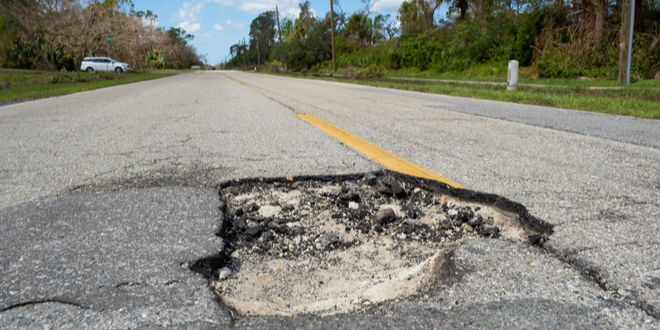All of the reports about Southern California’s infrastructure being in serious decline appear to be true, according to a report by an Anaheim-based nonprofit that spent one year investigating the matter.
The result of that effort is The High Cost of Underinvestment: Assessing the State of Infrastructure in Southern California, a 21-page study by Rebuild SoCal Partnership that paints a grim portrait of the region’s streets, roads, bridges and ports.
Infrastructure provides jobs, drives the economy and helps create a better quality of life, yet Southern California’s infrastructure faces “disinvestment, aging, overuse, and extreme climate conditions,” the report notes in its opening statement.
“While Southern California has made substantial investments in many areas, our aging roads, bridges, transportation, and water management systems aren’t ready for a competitive, technologically-enhanced future,” the report states.
The study – compiled by Blue Sky Consulting Group in Oakland, which specializes in economic and political research – presents a point-by-point breakdown of the major flaws in Southern California’s infrastructure, including:
- Infrastructure spending in the region has fallen 37 percent in the last 10 years;
- Southern California’s roads and bridges have gotten worse during the past decade, with no more than half of them today in good condition:
Several other western states that California competes with economically – Texas, Oregon, Utah and Nevada – spend more on infrastructure than is spent in Southern California; - If Southern California were a state, it would rank 22nd in the nation in infrastructure spending and last in building and upgrading highways;
- Riverside County is one of three Southern California counties whose roads have been designated “at risk” by the state because of pavement deterioration. San Diego and Imperial counties are the other two.
- About half of Southern California’s water systems have either failed during the last 10 years or are at risk of failing today. Also, half of the regions water systems don’t meet state standards regarding leaks, causing more than 84 million gallons of water to be lost per day.
Finally, in what could be the most serious long-term infrastructure issue facing the region, about $5.7 billion will have to be invested in Southern California’s ports during the next decade to keep them operating properly.
The overall portrait is of a region that is endangering its long-term economic future by falling far behind on infrastructure, said Jon Switalski, executive director of Rebuild SoCal Partnership.
“Infrastructure drives the economy, and there’s been a severe drop in spending, and it’s starting to catch up with us,” Switalski said.
The study makes a strong case for infrastructure spending being an economic driver. It found that $1 billion spent in that sector generates between $2.6 and $4.1 billion in economic activity and creates approximately 15,000 jobs.
“Building roads, bridges and highways is the best investment we can make,” Switalski said. “But we’re going to have really serious problems in 10 to 15 years if we don’t start doing something now.”
The report received no public funding and was commissioned by two of ReBuild SoCal Partnership’s client groups – contractors and union members – both of which saw a need for an analysis of Southern California streets, roads, bridges and highways.
Much of the problem can be traced to the state legislature in Sacramento, which for years has made it difficult to get anything built, according to Switalski.
“There are too many onerous regulations in California, and it takes way too long to get anything permitted,” Switalski said. “Look at high-speed rail. That’s an important project for the entire state and it’s taken forever to get it off the ground.
“It’s the same thing if you’re trying to finish a bridge somewhere.”
The report will be a valuable tool for local governments, but mostly it confirms in great detail what most people who work in local government already know, said Tim Watkins, chief of legislative and public affairs for the San Bernardino County Transportation Authority.
“It’s a good report, but there really aren’t any surprises in it,” said Watkins, who said he was “familiar” with the study but had not read the entire document. “The challenge will be to fix those problems,.”
One problem with infrastructure spending is that infrastructure projects typically vary greatly from one county to another.
“Sacramento has some state policies, but most of them will work in some places but not in others,” Watkins said. “What will work in San Bernardino County won’t necessarily work in San Francisco County.
“There’s no one-size-fits-all approach to infrastructure.”
Locally, the biggest takeaway from the report is the money that will be needed for port upgrades, according to Watkins.
“Five point seven billion is a big investment, but it’s very important for the Inland Empire that that happen,” Watkins said. “The Los Angeles ports get a lot of goods from China, and a good chunk of that ends up in the Inland Empire.”
 IE Business Daily Business news for the Inland Empire.
IE Business Daily Business news for the Inland Empire.


